What Is The Smallest Animal In The Amazon Rainforest
1 / 17
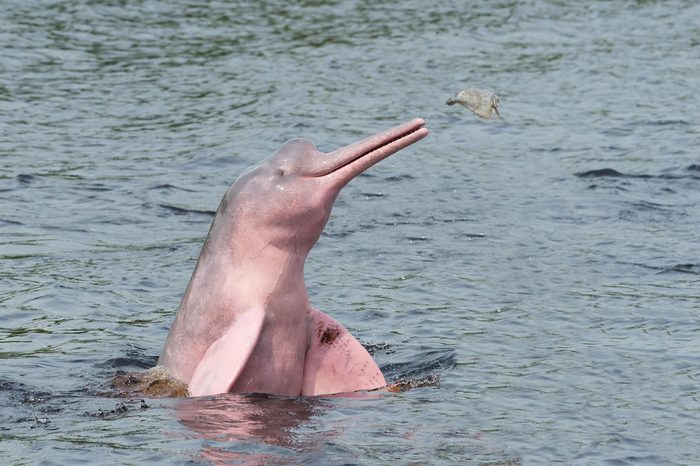
Amazon river dolphin
Of the animals that live within the Amazon River itself, this pink freshwater dolphin is a oversupply favorite. Besides called a botto or a pinkish river dolphin, tens of thousands of the long-nosed creatures remain. Only, because of threats acquired by dams and by water and nutrient contamination from mining, the dolphin is classified as vulnerable by the World Wildlife Fund (WWF): Some fishers even injure or kill them, believing they're a threat to diminishing fish stocks. Steps are underway to assistance. For example, in 2018, Peru created a new national park, Yaguas, nigh the Colombian edge to help protect the pink dolphins and the Amazon'southward other unique wild fauna. Pinkish dolphins remain ane of the twenty unexplained mysteries of the Amazon rainforest.
2 / 17
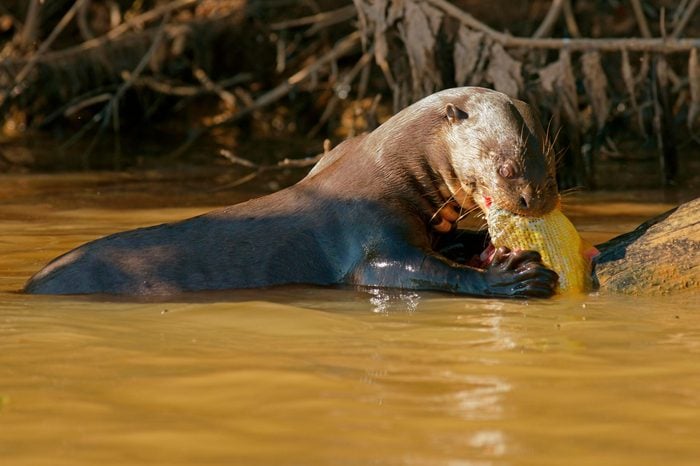
Giant otter
This endangered otter is establish only in remote parts of the Amazon where it's estimated only 2,000 to v,000 remain. Habitat loss continues to threaten them, though most were wiped out by hunters wanting their luxurious fur. Jeremy Goodman PhD, the executive director of Roger Williams Park Zoo, describes the mammals every bit "ane of the most endearing species" and "very loud." Y'all can see and hear the mammals at his Providence, Rhode Island zoo. One of the all-time spots for seeing them in the wild is at Republic of peru's Heath River Wildlife Middle.
3 / 17

Bald uakari
Unique Amazon mammals besides live in the rainforest trees throughout the river bowl. The bald uakari is i of them. Their bright cherry faces wait a trivial devil-like when they bare their teeth and those jaws are powerful enough to crack open a Brazil nut. These brusque-tailed primates eat only fruits and veggies simply are threatened by humans who sometimes hunt them for nutrient. A bigger risk for the primate is deforestation. The extinction of animals similar the balk uakari is one of the things that could happen if the Amazon rainforest disappeared.
four / 17

Gray woolly monkey
Gray woolly monkeys alive at distance in the fog forests of the Amazon, primarily in Peru and Brazil. Most 18 to 23 inches long, they have a long thick tail and a potbelly. In fact, their name in Brazil is macaco barrigudo, which means "large-bellied monkey." They're classified as threatened. The New England Primate Conservancy reports that over the terminal half-century, 50 pct of the population has been lost, largely due to clearcutting of forests for mining and agriculture. Babies are as well kidnapped for the illegal pet trade and their mothers killed in the process. These are more of the endangered animals that could disappear in your lifetime.
v / 17
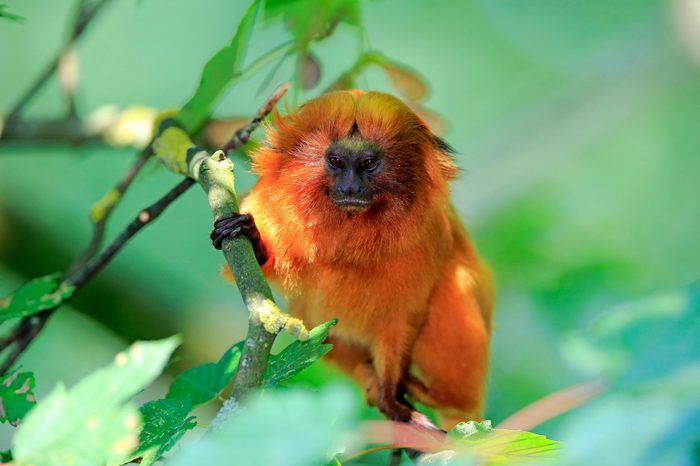
Golden king of beasts tamarin
The endangered golden lion tamarin, also called the gold marmoset, is found mainly in Brazil's rainforests. As the rainforests are logged and turned into agronomical and industrial land, the primates are at serious risk, according to National Geographic. These cuties are about 8 inches long and take manes similar African lions. Males help raise their offspring, which seems especially needed because most tamarin families accept twins. At that place are more great animate being dads that contribute their fair share in this listing of 23 "facts" about animals you have all wrong.
6 / 17
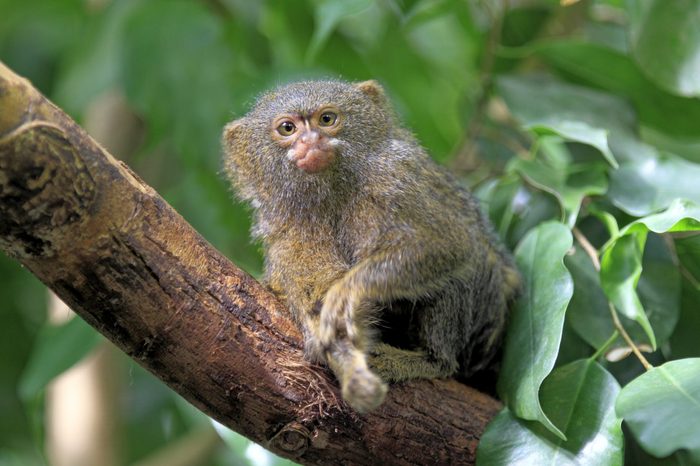
Pygmy marmoset
Pygmy marmosets, sometimes chosen pocket monkeys, are even tinier than they announced considering their fur is so fluffy. Weighing just five ounces, they could easily fit into the palm of your hand. They like to live high in the treetops where they can find their favorite food: tree gum and sap. They'll swallow fruit and insects if necessary. They have a loftier baby mortality rate, due to starvation and falling out of copse, with simply 25 percent of babies reaching adulthood. Like the gray wooly monkey, the pygmy marmoset is kidnapped and sold illegally equally pets. Deforestation is besides a threat. They're the smallest of all monkeys and one of the 10 cutest tiny animals from around the world.
7 / 17
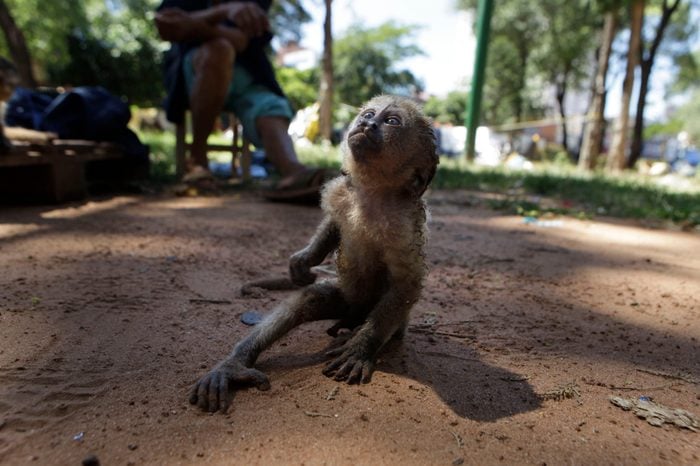
San Martin titi monkey
This tiny chocolate-brown-gray monkey is critically endangered. That's just 1 step away from being extinct in the wild, according to the IUCN'due south Red Listing of Threatened Species. Humans are taking over these creatures' territory to build roads, farms, and housing, and the monkey is sold on the black market place equally meat. It lives only in north-cardinal Peru. The Rainforest Trust calls information technology "Peru's most imperiled primate" and is raising coin to create a conservation area.
8 / 17
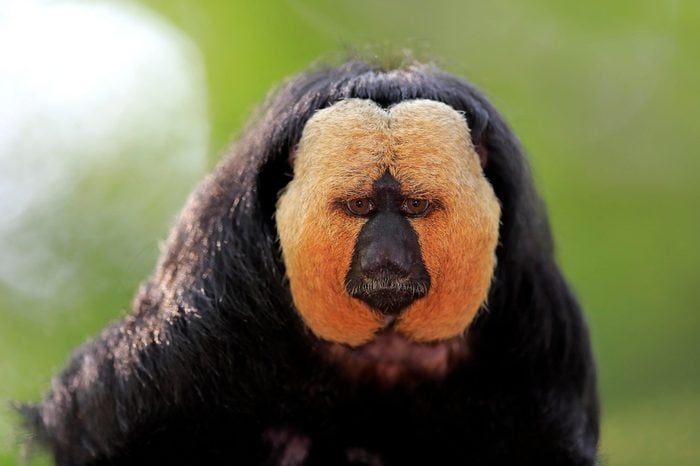
Stake-headed saki monkey
In one case you come across a moving picture of a stake-headed saki monkey, you'll never forget this distinctive-looking primate. The males have a brusque-haired white face up and a long-haired black body, while females are grayer and have a stripe on their faces. They live in the trees of the Amazonian rainforest. These monkeys are strong jumpers and accept been seen leaping over 30 feet to escape a predator. Living nearby are various monkey cousins, including the brown-backed bearded saki monkey which is found in Brazil's Amazonian Rio Negro region. These are more than animals that are only constitute in one place in the globe.
nine / 17
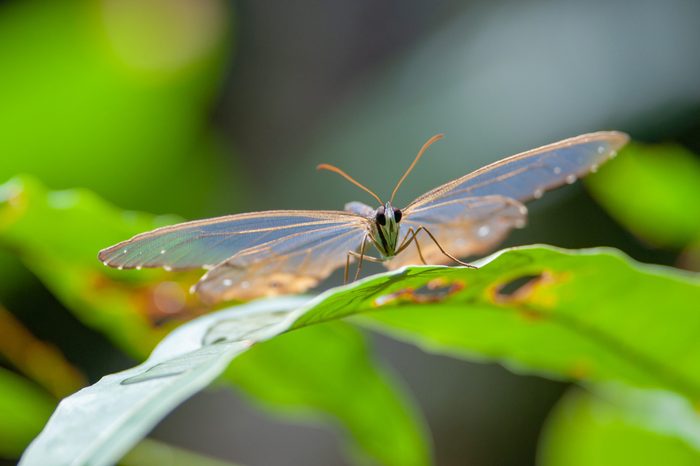
Amber phantom butterfly
Living in the deepest shade of the Amazon rainforest from sea level to most v,000 anxiety is the haetera piera butterfly, too called the amber phantom. Its wings are transparent with a carmine or bister tint. They're most easily spotted at sunset when they feed on rotting fruits and decomposing mushrooms on the forest floor. Here are vi delightful facts virtually butterflies, including that they're near equally one-time as dinosaurs.
10 / 17
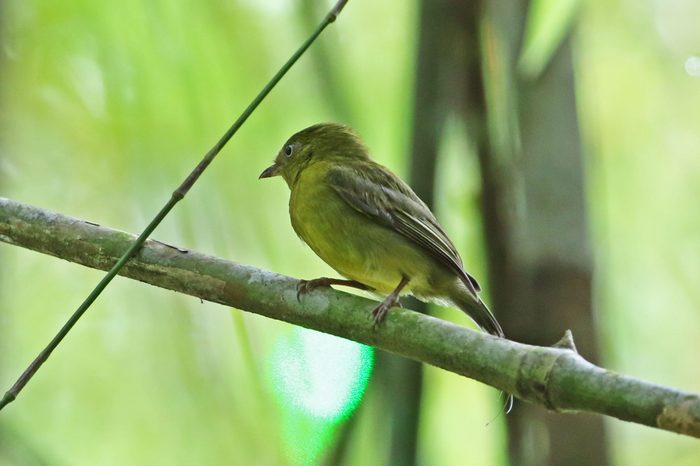
Wire-tailed Manakin
Many birds are endemic to the Amazon rainforest too. The wire-tailed manakin is a blackbird with a vivid xanthous face up and abdomen that looks like information technology's wearing a red hood. Establish simply in the western Amazon Basin, it'due south known for having one of the bird world's most elaborate mating dances. Birdwatchers have a good chance of seeing the elusive bird with Traverse Journeys' Rainforest Encounter Ecuador bout considering manakins frequent a spot most their ecolodge.
eleven / 17
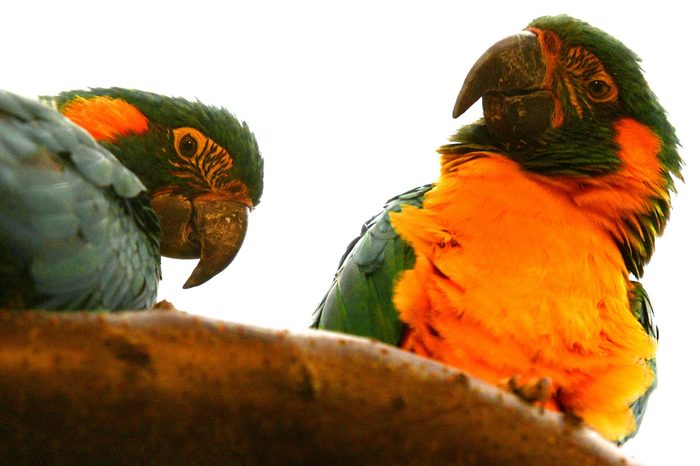
Blue-throated macaw
This big blue-green and yellow bird was thought to have become extinct in the 1980s, due to deforestation and poaching for the pet trade. But about 50 of the birds were found in Bolivia in 1992, co-ordinate to the American Bird Conservancy. Blue-throated macaws similar to nest in large trees, of which there are few remaining. So, the American Bird Conservancy and its Bolivian counterpart have been working to designate land to protect them and encourage them to apply nest boxes. The macaws are adapting and it's estimated that the population is now around 450. Blue-throated macaws aren't the but endangered animals making a improvement.
12 / 17
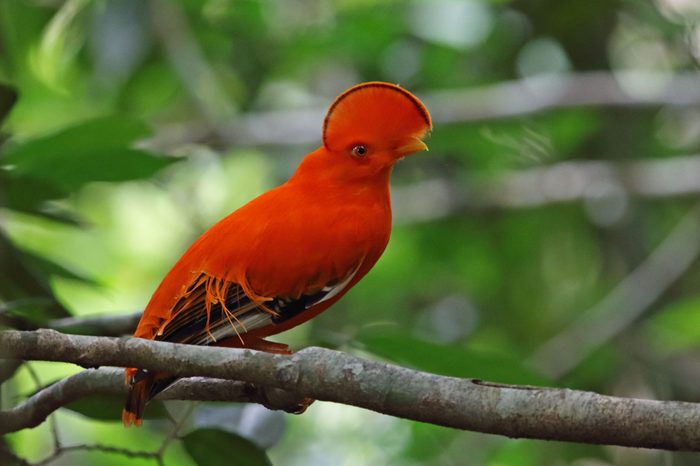
Guianan cock-of-the-rock
This 10- to 12-inch alpine bird lives in the rainforests of Colombia, Venezuela, and Brazil. They have a distinctive one-half-circle crest on their heads. The males are vivid orange and the females are olive-gray. In his A Volume of Rather Foreign Animals, Caleb Compton describes the bird's "dance-off" mating ritual. Females watch as about 40 males put on an elaborate courtship brandish, hoping to receive a peck on the back from a female person, the sign that she's chosen him. They're a cousin of the Andean cock-of-the-rock, the national bird of Peru, which is even more than distinctive looking. They accept a much larger crest on their heads.
14 / 17
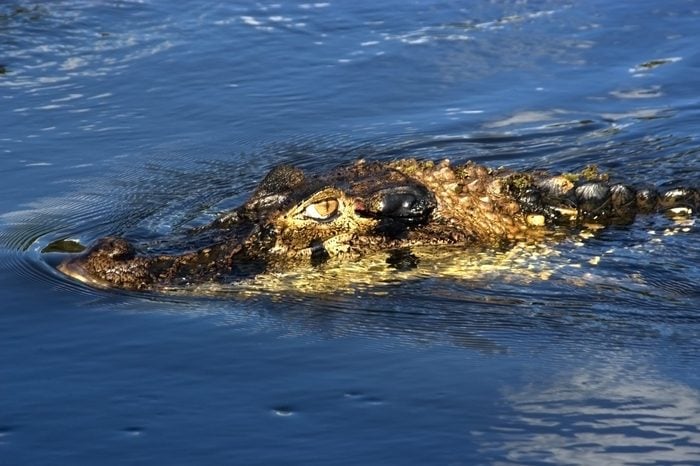
Black caiman
A less-friendly water dweller is the black caiman. This immense alligator can grow 15 feet long, making information technology the Amazon Basin'due south largest predator. They kill their prey, which includes deer and tapirs, in a grisly way—first drowning it and and so swallowing it whole. As hatchlings, the caiman is preyed on by birds, rodents, and other animals. The main threat to the black caiman adults is humans. We kill them for their meat and hide, cut down the trees supporting their nutrient, and burn their swamplands.
15 / 17
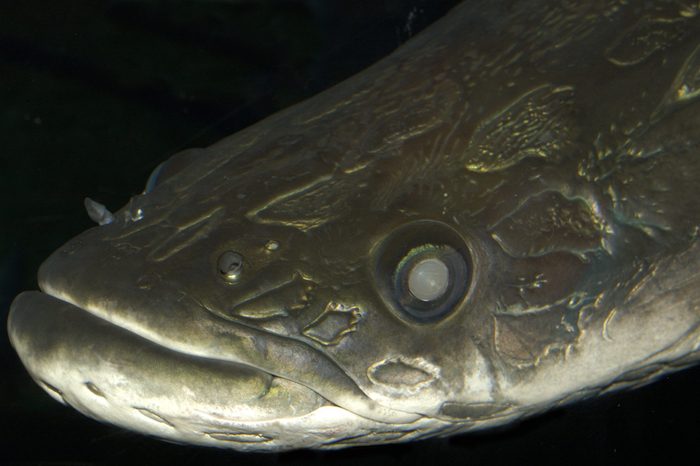
Arapaima gigas
Also swimming through the Amazon and its tributaries, lakes, and swamps is the arapaima fish. In Brazil, it's called a pirarucu and the name in Republic of peru is paiche. This mega fish is i of the world's largest freshwater fish reaching lengths of ten feet and weighing 40 pounds (the earth'due south largest fish is the whale shark—1 of the facts that you lot probably didn't know about whale sharks). These are air-breathing fish that breathe with a cough noise. Because of this, they stay close to the water's surface which makes them all besides piece of cake to catch with a harpoon; the arapaima's main threat is overfishing.
16 / 17
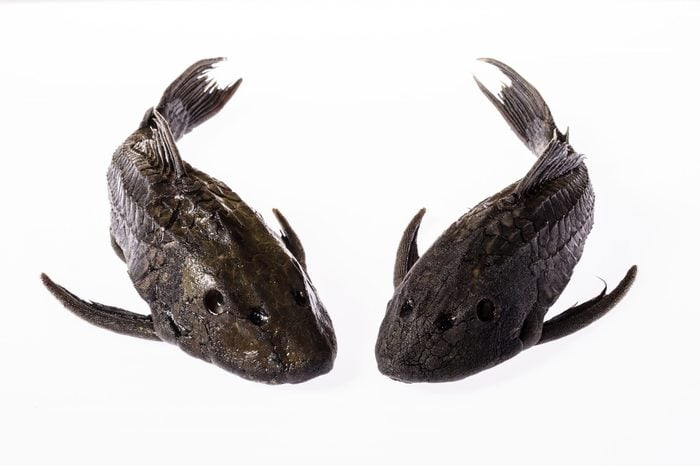
Carachama
Some other fish unique to the Amazon is the carachama, a type of catfish. The fish's blackness and grey scales form a kind of armor protecting it from the other fish found in the Amazon'southward rivers. It used to be a pop fish for soup and for grilling, but information technology is at present illegal to fish for it in many areas. Today, pollution is the biggest risk to carachama.
17 / 17
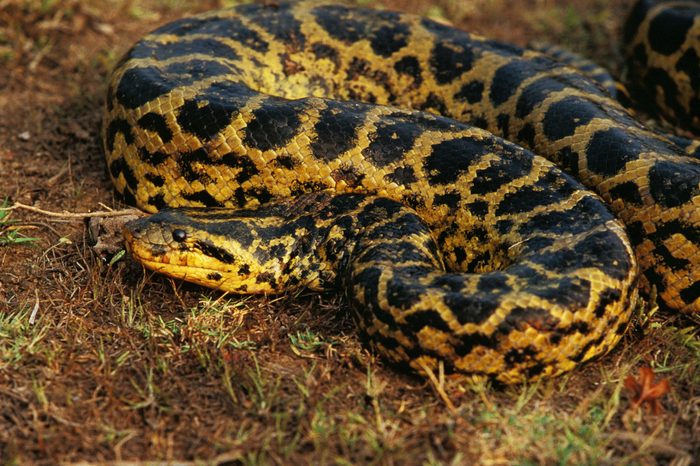
Green anaconda
Living sometimes in the water and sometimes out, is the green anaconda. It's the largest snake in the globe weight-wise (the reticulated python can grow longer, but weighs only half as much), reports National Geographic. The green anaconda is 20 to 30 feet long and weighs over 500 pounds. A fellow member of the boa constrictor family unit, anacondas squeeze their casualty and then swallow it whole, fifty-fifty something as large as a jaguar. At present, read on for these amazing discoveries to come out of the Amazon rainforest.
Originally Published: August 27, 2019
Source: https://www.rd.com/list/animals-in-the-amazon-rainforest/
Posted by: thomasthadvating.blogspot.com

0 Response to "What Is The Smallest Animal In The Amazon Rainforest"
Post a Comment